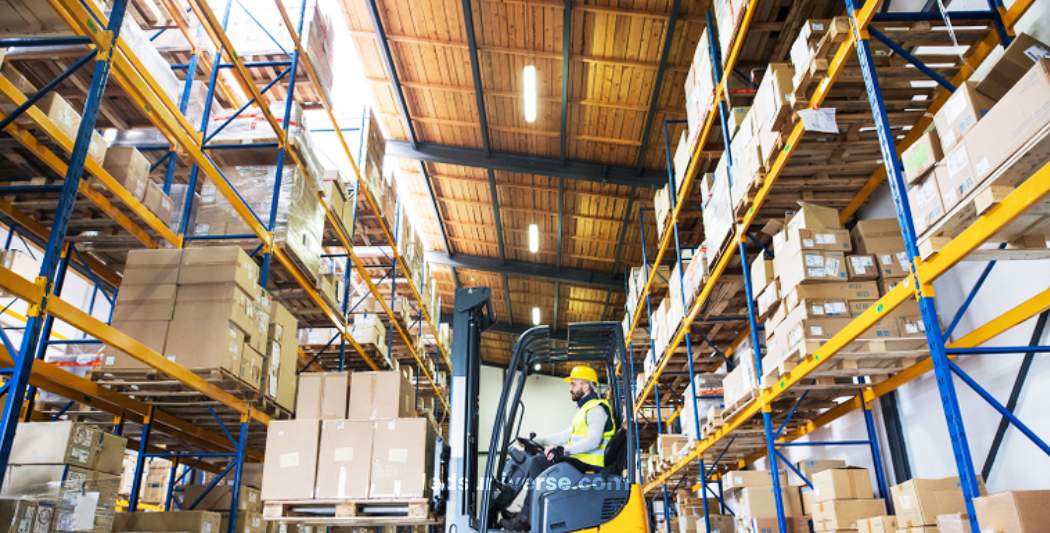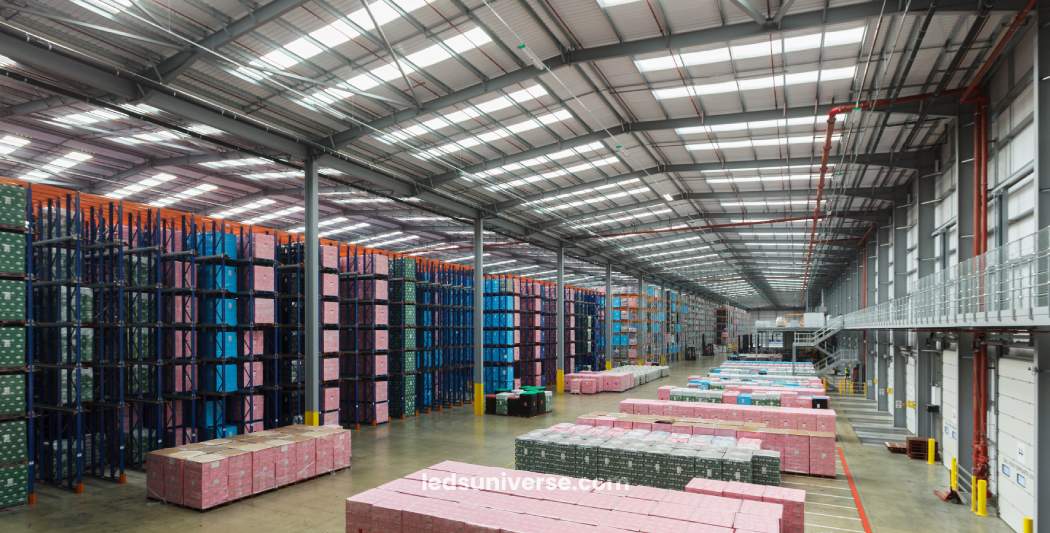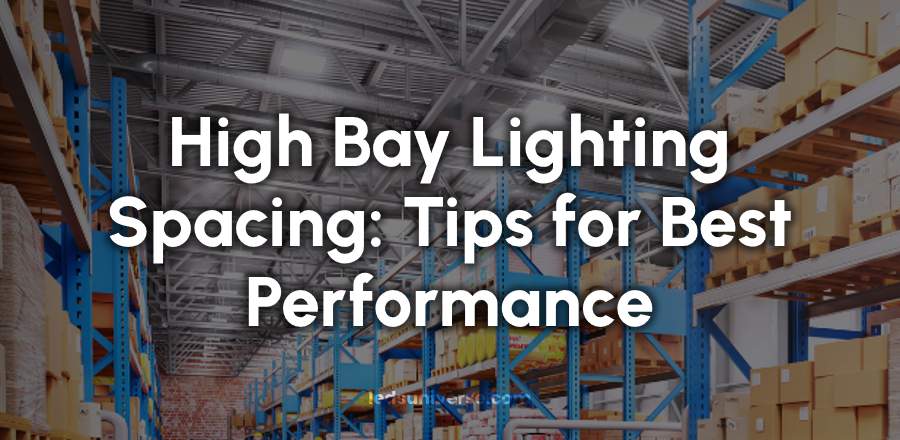Proper lighting design plays a significant role in creating a well-lit, efficient, and safe environment for various commercial and industrial applications. When considering high bay lights for your space, it’s important to focus on the right arrangement and spacing. The effectiveness of high bay lighting systems depends not only on the quality of the fixtures but also on their proper placement. High bay lights are typically designed for use in large, high-ceiling environments like factories, warehouses, and retail spaces. Their illumination capacity allows them to brighten vast areas with minimal energy use.
In this guide, we will explore how to optimally space high bay lights in different settings, discuss their applications, and provide tips on how to arrange them to maximize lighting efficiency.

Table of Contents
ToggleWhat Are High Bay Lights?
High bay lights are lighting fixtures designed for large spaces with high ceilings, generally ranging from 20 to 50 feet in height. Due to the height of these ceilings, high bay lights are specifically built to emit powerful, concentrated illumination that can cover large areas effectively. Their design makes them suitable for commercial and industrial environments, where visibility and consistent lighting are paramount.
The versatility of high bay lights means they are widely used in factories, warehouses, gymnasiums, and retail environments. Depending on the needs of a specific space, there are many variations of high bay lights, including those designed for energy efficiency, enhanced durability, or specialized lighting conditions like cold storage or explosive environments.
Factors Influencing High Bay Light Spacing
Ceiling Height and Light Intensity
The height of the ceiling is a primary factor in determining how far apart high bay lights should be installed. As the height increases, the distance between the lights must be adjusted to maintain adequate brightness and uniform coverage. In lower ceiling environments, closer spacing helps to prevent shadowing and ensures consistent lighting levels. In spaces with higher ceilings, lights can be spaced further apart without sacrificing visibility.
Light Distribution and Beam Angle
The beam angle of high bay lights affects how the light spreads across the area. A wider beam angle provides broader coverage, which allows for more uniform lighting with fewer fixtures. In contrast, a narrower beam angle focuses light more intensely over a smaller area, making it suitable for targeted lighting in specific zones. When determining the spacing of high bay lights, it is essential to consider the beam angle of the fixtures being used to ensure optimal light distribution.
Brightness Requirements
The required brightness for a space depends on its function. Spaces where precision tasks are carried out, such as manufacturing facilities or workshops, will need more intense lighting than areas used for general purposes like storage. High bay lights with a higher lumen output are necessary for brighter lighting, while lower-lumen options may be sufficient for other applications. The brightness level directly impacts how far apart the lights should be spaced; more powerful lights can be spaced further apart, while less intense lights should be installed closer together.
Spacing High Bay Lights in Different Settings
Factory and Warehouse Lighting
In factories and warehouses, high bay lights play a vital role in maintaining a well-lit environment for workers and machinery. Proper spacing of these lights helps enhance visibility, reduce accidents, and improve productivity. For factories with ceilings ranging between 15 to 20 feet, high bay lights should be spaced between 10 and 14 feet apart, depending on the brightness level desired. In taller factories with ceilings as high as 30 feet, lights can be spaced up to 25 feet apart, though this may vary depending on the specific requirements of the workspace.
In warehouses, consistent lighting is especially important for safety and productivity, as workers often operate machinery or move goods in tight spaces. The spacing of high bay lights should be adjusted to ensure even lighting without creating dark zones or overly bright spots. At heights of 20 to 30 feet, lights should be spaced between 16 and 20 feet apart. If the ceiling height exceeds 30 feet, spacing the lights 20 to 25 feet apart will maintain a balanced level of brightness across the space.
Cold Storage Lighting
Cold storage facilities present unique lighting challenges due to their low temperatures and specific requirements for energy efficiency. High bay lights are particularly well-suited for these environments as they provide strong, even illumination without generating excessive heat. In cold storage environments with ceilings ranging from 20 to 30 feet, high bay lights should be spaced approximately 16 to 20 feet apart. Wider spacing may be appropriate if a more uniform lighting effect is desired.
High bay LED lights are especially effective in cold storage applications, as they offer high energy efficiency and durability in low-temperature conditions. They are also less likely to emit excess heat, which is essential for maintaining the optimal temperature of the storage space. Additionally, LED high bay lights can be equipped with motion sensors to further improve energy efficiency by only turning on when necessary.
Retail and Commercial Lighting
In retail and commercial spaces, lighting plays a significant role in enhancing the customer experience while keeping energy costs under control. High bay lights are often used in large retail stores, showrooms, and malls, where consistent and attractive lighting is important. Depending on the ceiling height and layout of the space, high bay lights should be spaced anywhere from 10 to 16 feet apart for ceilings ranging from 15 to 25 feet high.
Retail environments benefit from a combination of direct and ambient lighting to create a welcoming atmosphere for shoppers. In this context, high bay lights with a broader beam angle can help achieve even light distribution, reducing shadows and enhancing product visibility. Additionally, selecting high CRI (Color Rendering Index) lights can further enhance the appearance of products by making their colors appear more vibrant.
Gymnasium Lighting
Gymnasiums are another common application for high bay lights due to their large, open spaces and high ceilings. Proper lighting ensures that athletes and spectators can clearly see the playing area, which improves safety and the overall experience. In gymnasiums with ceiling heights of 25 to 30 feet, high bay lights should be spaced around 20 feet apart. For higher ceilings, spacing can be increased to 25 feet to accommodate the broader coverage provided by more powerful lights.
Gymnasiums often require high-output lighting to maintain visibility during fast-paced activities. LED high bay lights are an excellent choice in these environments, as they offer bright, consistent light with minimal energy consumption. Their long lifespan and low maintenance requirements also make them a cost-effective solution for gymnasium lighting.
Manufacturing Facility Lighting
In manufacturing facilities, proper lighting is essential to ensure safe and efficient operations. High bay lights are used to illuminate large open areas where workers may be performing tasks that require precision. The layout and spacing of high bay lights should be carefully planned to avoid creating dark zones that could lead to accidents or reduced productivity.
For facilities with ceilings between 20 and 30 feet, spacing the lights 16 to 20 feet apart is generally effective. In areas where more intense lighting is required, such as production lines or assembly areas, the lights should be spaced closer together to achieve higher brightness levels. In taller facilities, with ceilings over 30 feet, lights can be spaced up to 25 feet apart without compromising on lighting quality.
Arranging High Bay Lights on the Ceiling
When designing the layout for high bay lights, the goal is to create an evenly lit space that minimizes glare and shadows. In factory settings, the lighting arrangement should be designed to optimize visibility across the entire work area. The alignment of the fixtures should be consistent, and the lights should be positioned to provide overlapping coverage, ensuring that no dark spots are left in the workspace.
The use of lighting grids or matrix arrangements can be an effective way to achieve uniform lighting. In a matrix layout, the fixtures are evenly spaced in a grid pattern, ensuring consistent coverage across the entire floor. This arrangement also helps minimize glare and shadowing, which is particularly important in environments where workers are performing tasks that require visual precision.

Choosing the Right Type of High Bay Lights
Different environments require different types of high bay lights, depending on the specific needs of the space. When selecting high bay lighting fixtures, it is essential to consider factors such as durability, ease of maintenance, and resistance to dust, water, and other environmental conditions. For example, explosion-proof lights may be required in hazardous environments, while waterproof or dustproof lights are more appropriate for manufacturing or cold storage facilities.
The type of lighting used also depends on the desired energy efficiency. LED high bay lights have become a popular choice due to their long lifespan, low energy consumption, and excellent brightness. Additionally, LED fixtures often come with advanced features such as dimming capabilities and motion sensors, which can further improve energy savings and lighting control.
Applications of High Bay Lights
Warehousing and Logistics
Warehouses and logistics centers are large spaces that require consistent and powerful lighting to maintain safety and productivity. High bay lights are ideal for these environments, as they can provide sufficient brightness even in spaces with high ceilings. The use of high bay lights in warehouses helps improve visibility for workers, making it easier to move goods, operate machinery, and navigate the space safely.
Manufacturing and Industrial Spaces
In industrial settings, high bay lights provide the necessary illumination to perform a variety of tasks. Their durability and energy efficiency make them well-suited for manufacturing facilities, where they can help improve safety and productivity. High bay lights with a high CRI are particularly useful in environments where color accuracy is important, such as assembly lines or quality control stations.
Commercial and Retail Spaces
High bay lights are commonly used in large retail spaces, such as big-box stores, malls, and showrooms. Their ability to provide bright, even illumination makes them ideal for creating an attractive shopping environment. Additionally, energy-efficient high bay lights can help reduce operational costs for retailers while maintaining high-quality lighting.
Cold Storage Facilities
Cold storage facilities benefit from high bay lights due to their ability to operate efficiently in low-temperature environments. LED high bay lights are particularly well-suited for cold storage, as they provide bright, consistent light without generating excess heat. This helps maintain the optimal temperature within the facility while ensuring that workers can perform their tasks safely.
Gymnasiums and Sports Arenas
High bay lights are also used in gymnasiums and sports arenas to provide bright, even lighting for athletes and spectators. The high ceilings of these spaces require powerful lights that can cover large areas without creating shadows or dark spots. LED high bay lights are an excellent choice for these environments, as they offer bright, uniform illumination with minimal energy consumption.
Conclusion
Spacing high bay lights correctly is critical to achieving optimal lighting efficiency in large spaces. By considering factors such as ceiling height, beam angle, and brightness requirements, you can create a well-lit environment that enhances visibility, safety, and productivity. Whether you’re lighting a factory, warehouse, or retail space, proper high bay light spacing will ensure consistent illumination throughout your facility, reducing energy costs and improving overall performance.
